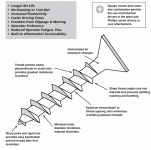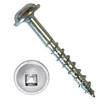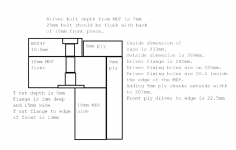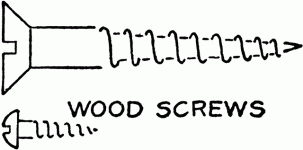I'd always assumed that T-nuts or well-nuts would be the way to go, but I have a cabinet (doesn't have a front) that is the right volume for a driver I'd like to use and the chassis will sit inside - but there is not enough clearance to place t-nuts or well-nuts.
On the other hand, I guess I can reinforce the walls somewhat and the back of the front piece, and use wood screws.
Is it likely to be a problem?
On the other hand, I guess I can reinforce the walls somewhat and the back of the front piece, and use wood screws.
Is it likely to be a problem?
Maybe you could post some photos to clarify what exactly you're dealing with? I'm personally not a fan of T-nuts, and had to look up wellnut fastener - I'd be worried about how securely those would hold - of course I'm guessing that would depend on the type and thickness of substrate into which it would be fitted. If you're talking about fixed wood baffles too thin for an external threaded insert fitting, I'd be inclined to drill pilot holes and use coarse thread sheet metal screws. Of course, there's a limit to the number of times such a driver can be installed and removed using any type of screw in a wood baffle before the core is at risk of being stripped.
There may be problems getting a good grip in MDF. Use of a parallel shank screw is recommended for both MDF and plywood. Make the screw as long as possible rather than fat. Reinforcing behind the panel to give something more for the screws to grip into may be a good idea. For a more permanent fix in MDF you can put a few drops of PVA wood glue into the pilot hole.
P.S. I know wellnuts as 'Rawlnuts'. These are commonly used for attaching thin items to panels - a bathroom cabinet to a hollow plasterboard wall for example.
Provided your loudspeaker mounting flange is thin, then Rawlnuts would do the job - I can't see why you couldn't use them?? However, you must choose ones of an appropriate length. A Rawlnut will allow you to remove and replace the speaker without having to replace the fixing.
Provided your loudspeaker mounting flange is thin, then Rawlnuts would do the job - I can't see why you couldn't use them?? However, you must choose ones of an appropriate length. A Rawlnut will allow you to remove and replace the speaker without having to replace the fixing.
Attachments
I'm planning to use washers and bolts. Not sure I understand your point about rotation.
The issue I have is that I am reusing a cabinet that I bought from Wilmslow, and I want to use a driver that's rather large. The basket will fit but the mounting diameter for the screws will not.
So I think rawlnuts (seems its a brand, there are at least 3 manufacturers) are out. I can use T-nuts and install before I put the cabinet front on, so long as the bolts do not stick out the back. My plan is to install without rebating the flange and then laminate on a decorative panel (the driver has a 10.5mm flange so I can add plenty more thickness).
I also have a 3-way cab that's unfinished MDF and very solid (the vendor is professionally a triple glazed window manufacturer) - from ebay. 25mm front but not predrilled so T-nuts are out.
M5 rawlnuts that are long enough - I found some. But I'm struggling to find M4 or M3 that will do. The M4s I have were the longest I found and allow 6-14mm range.
Perhaps threaded wood insert nuts will do for mid and tweeter.
Given that threaded wood insert nuts can be had with quite long length and seem to have a good reputation - is there a reason not to use them? They seem popular for spikes etc but I don't recall seeing them used for driver attachment.
The issue I have is that I am reusing a cabinet that I bought from Wilmslow, and I want to use a driver that's rather large. The basket will fit but the mounting diameter for the screws will not.
So I think rawlnuts (seems its a brand, there are at least 3 manufacturers) are out. I can use T-nuts and install before I put the cabinet front on, so long as the bolts do not stick out the back. My plan is to install without rebating the flange and then laminate on a decorative panel (the driver has a 10.5mm flange so I can add plenty more thickness).
I also have a 3-way cab that's unfinished MDF and very solid (the vendor is professionally a triple glazed window manufacturer) - from ebay. 25mm front but not predrilled so T-nuts are out.
M5 rawlnuts that are long enough - I found some. But I'm struggling to find M4 or M3 that will do. The M4s I have were the longest I found and allow 6-14mm range.
Perhaps threaded wood insert nuts will do for mid and tweeter.
Given that threaded wood insert nuts can be had with quite long length and seem to have a good reputation - is there a reason not to use them? They seem popular for spikes etc but I don't recall seeing them used for driver attachment.
Perhaps threaded wood insert nuts will do for mid and tweeter
They will. They are also perfect for mounting larger stuff, including bass drivers. You can always use a drop or two of wood glue to fix the nuts in place (but you will then not be able to remove them if you need to).
Use hex-head (Allen) or Torxx machine screws (I prefer black ones) to fit the drivers in place so there is no risk of the screw bit slipping and ruining your day. Add a drop of LocTite to each screw if you're worried about them working loose. (They won't.)
Just make sure you use the largest possible diameter screws (and matching insert nuts) to fit the holes in each driver chassis and you cannot go wrong.
Marcus
As chrisb said in post #2, maybe you could post some photos to clarify exactly what you're dealing with? I, for one, am finding it difficult to understand what you are trying to achieve.
They're in the garage at the moment and if its no raining I'll haul them out.
I'm not sure how its hard to visualise.
But there are two things here:
- I have some MDF CNC cabs based on an old design from Wilmslow Audio - they were HSM with a different front piece. They are entirely 18mm construction, CNC routed and they have gone together (minus frount piece) very precisely.
- I have some 3-way cabs that I bought on EBay. They are 31cm by 353.5cm by 78cm, and have a mid section and a section for bass and tweeter. Front is 25mm MDF, rounded on the edges. The rest is 18mm. Rebates for drivers are 104x3, 78mm cutout, 148x6, 125mm cutout, 255x9, 227mm cutout.
Both are currently unfinished MDF.
I have scanspeak drivers that are 149+- and they do not fit. I have scanspeak bass drivers that do fit. I suspect that Seas 27 series tweeters will fit. I also have some Satori 24WO-8.
So two different problems:
- can I fit the 24WO-8 into a cabinet that is a bit narrow for them, but about the right volume? This cab does not have a front on it yet: I built the rest but not veneered etc.
- can I arrange to fit drivers to a solidly built MDF cab that I cannot remove the front from to fit T-nuts. Rawlnuts only work where they are OK with the 25mm front.
Currently I think like this:
The Wilmslow cabs can be used if I can make a custom front to fit the 24WO-8. But, I can't use rawlnuts because the diameter of the screw hole centres only just fits the inside of the cabs so there is no space for the nuts to compress and the rubber to flatten, and protruding bolt ends might also be an issue. The basket is fine, but not the fixing diameter - if I have anything protruding out of the back of the front MDF, it will foul the sides.
I can buy 18mm MDF easily, fasten the driver with no rebate. Empirically the depth of the screw head is 7mm from the front of the cabinet in that case, so I could use 25mm M5 nut with an T-Nut rebated to be flush. I also have some 1mm M5 black nylon washers to be safe. I just need 25mm long M5 black bolts. I think this is under control now.
The other cabinet is a pain:
- the midrange rebate is quite deep - and just a bit small.
- the woofer rebate is a bit deep.
- the tweeter rebate is 'standard 104mm' but rather shallow (no Satori tweeter for me unless I can route it)
- the front is solid 25mm MDF. There is no roundover for mid and tweeter so I might have to live with that or try some retro-cut that fits with the mountings.
I believe there is no issue with clearance to use rawlnuts or T-Nuts, but the cabinet front is on and has not been drilled for driver mounting and the extra drilling for T-Nut bodies isn't in-place. So T-Nuts are not an option. And rawlnuts don't come long enough except in M5. Also I can't mount proud of the front and mount a decorative fascia because it has roundover on the corners, so I have to step up with veneering or just finish the MDF with paint.
It was cheap, and its a challenge, but the box is very sturdy. A few dings, but some veneer would hide that. I'm more confident to pad the existing rebated driver holes for depth than I am to try to enlarge them or make them deeper - even if I create a template to route within, fastening it securely so that I can use the router would seem difficult - and I'm not very experienced with the router.
Current thinking:
- M5 rawlnuts for the woofer
- use a 146mm Seas midwoofer or midrange (or Fountek FR135) in the midrange hole, fill with felt maybe and pad with 2 or 3mm of (something TBD).
- use a 103+_ Seas 27 series tweeter
- sand and spray the rounded front MDF and veneer the sides and top OR go to an auto wrap shop and ask them to wrap the speakers
I'm trying to convince myself that the Seas M15 midrange is a good fit. There is little comment on it, it seems. And it has cone edge breakup with wiggly axial response and elevated HD at about 1.2kHz - but I think lots and lots of paper cone drivers do that, including Satori.
I don't need to sort the crossover design first:
- in the short term, some very old power amps, with a mini-DSP crossover (I have all the bits I need here)
- eventually, perhaps Hypex plate amps, or something like the magiclx521 Powerbox 6Pro - but I'm not in a hurry at all.
- i currently have no intention to do a passive XO
I used to own some (passive) ProAc Studio3s, and I have heard ATC SCM50As several times. I'm quite convinced that 3-way is effective, and that a wideband midrange is key. But I definitely can't afford new SCM50As. Or Ebay ones, for that matter. Its a 90:10 thing.
The WO24Ps will go into a 'modular 3-way'. I do actually have a pair of Wavecor tweeters that I think would theoretically cross on axis without issue but the 24P and Wavecor are both going a bit nuts with HD around 1kHz so I've chickened out of putting them in the box with the WO24P even though it looks like a high order cross at 11 or 1.2 might work. Maybe I could rethink that because a separate modular midrange on top might work out. I could try lots of drivers, quite easily, because I 'currently believe' that most of the music will come from there.
Note; I'm in the UK (or Portugal) and the rooms are smaller than US or Aus rooms. I suspect that peak sound levels are less of an issue for us, which may in practice allow lower crossovers and to worry less about THD increase with level. Certainly some of the comments from Linkwitz and US reviewers make me think they in an environment that is quite unlike mine. However much I might want it, I don't think the neighbors want the orchestra to be in the room with me. Let alone AC/DC.
Thanks for your comprehensive reply. However, there's an old saying - a picture is worth a thousand words!Originally posted by jmansion >
I'm not sure how it's hard to visualise.
P.S. I am beginning to get the idea!
Last edited:
Thanks for your comprehensive reply. However, there's an old saying - a picture is worth a thousand words!
!
Attached:
WO24P-8 on the Wilmslow HSM. The slight rebates will get filled before I put the new front pieces on, and I will mount the driver much closer to the top. I had considered reserving some space for a 10F or B80 or similar and trying a WAW or whatever - but I'm not brave enough. I can make a series of separate enclosures for wideband or mid+tweeter anyway, and sit them on top and have a play. XO will be DSP so I can reconfigure without cost beyond drivers and cabinetry. In theory, anyway.
Also one of the MDF cabs off ebay, they are a mirror pair. I could just give up on them as too hard to fix given that there is no chamfering inside the mid rebates and they are just a bit small for standard 15cm ScanSpeak chassis (including ones for EAD and Jordan) - but it seems a shame.
Also for completeness, Scan 23W on the Wilmslow cabinet. This was in fact my original plan, after I bought the 23Ws on ebay, and before the 3-way cabs became available. The slight rebates on the sides are related to the way Wilmslow's CNC approach works. They may have told me it wouldn't quite fit, or that I would have some issues with mounting - I can't remember. I've had them a while, and HSM isn't even offered anymore.
Its rather tempting to go with this arrangement and new deeper fronts: the 23W models at 44Hz F3 in this cabinet, sealed - about 10Hz lower than the Satori. But its less flexible in terms of crossover points for WAW experiments.
Attachments
It’s what looks like a relatively narrow margin on that rebated driver cutout for the woofer that I think might cause you some issues with any type of fastener that requires a larger pilot hole than the shank of the machine screw itself.
MDF is notorious for being fragile that close to the edge, and in my experience even more particularly so with as large a pilot hole as would be required, and when the hardened face is removed by rebating as is the case here. If you have scraps, I’d be inclined to experiment with sheet metal screws, no larger than #10, and very carefully sized pilot holes. As long as you don’t plan on removing the drivers numerous times, you’re not likely to strip the MDF’s core.
There are a variety of wood screws designed specifically for use in MDF, but I’ve only ever seen them with flatheads, often nibbed for countersinking, or with a washer round head that could be too large for recessed mounting hole on driver flange, and never larger than #8. The former is a much better construction fastener. I’d counsel against using gyproc / drywall screws in MDF or plywood.
MDF is notorious for being fragile that close to the edge, and in my experience even more particularly so with as large a pilot hole as would be required, and when the hardened face is removed by rebating as is the case here. If you have scraps, I’d be inclined to experiment with sheet metal screws, no larger than #10, and very carefully sized pilot holes. As long as you don’t plan on removing the drivers numerous times, you’re not likely to strip the MDF’s core.
There are a variety of wood screws designed specifically for use in MDF, but I’ve only ever seen them with flatheads, often nibbed for countersinking, or with a washer round head that could be too large for recessed mounting hole on driver flange, and never larger than #8. The former is a much better construction fastener. I’d counsel against using gyproc / drywall screws in MDF or plywood.
Attachments
There are so many mounting holes on those drivers that the use of woodscrews would be more than adequate to mount them securely on the new front pieces.
That would take us back to my post #3.
Is there any reason why that wouldn't suit your Wilmslow box option?
I guess that's true but I was hoping to make something that would allow driver removal for maintenance, perhaps while finishing the box itself.
It’s what looks like a relatively narrow margin on that rebated driver cutout for the woofer that I think might cause you some issues with any type of fastener that requires a larger pilot hole than the shank of the machine screw itself.
That might be concerning. I can get 18mm ply if that would be a much better solution. I had been going to add further ply around the carcase anyway, and try to build up so that there is enough width that it does not shatter.
Whether of not I attempt to subsequently veneer - I'm not sure.
My CAD skills are a bit rubbish. Like my woodworking. ;-)
I've tried to show more or less to scale what I intend - but I had trouble adding dimensions in SmartDraw.
Attachments
If you do decide to use screws, avoid using an ordinary tapered shank wood screw as it acts like a wedge and pushes the MDF fibres apart.
A parallel shank screw is a better choice - like the sheet metal screw that chrisb has mentioned.
A parallel shank screw is a better choice - like the sheet metal screw that chrisb has mentioned.
Attachments
May I suggest that it would be less confusing if we concentrated solely on the Wilmslow cabinet?
I believe its less of a problem. Not least - because I can have multiple goes trying to build a front piece to the cabinet, before attaching it. Given my lack of skill with router and saw, that's good.
Inaccurate cuts on the other cabinet will be harder to recover from.
I'll try to draw what I intend with the other cabinet.
It’s what looks like a relatively narrow margin on that rebated driver cutout for the woofer that I think might cause you some issues with any type of fastener that requires a larger pilot hole than the shank of the machine screw itself.
Thank you - I think that's a great call.
Indeed I tried drawing a mounting for the 23W woofers. The cutout in the cabinets is very slightly larger than the specified 225mm - its about 227. And the outer rebate is about 255mm - its quite tight. The flange is about 14mm wide, and the M5 mounting holes are on 240 centres.
So, a 10mm wide rawlnut is going to have 2mm of MDF between it and the cutout. And the wider lip only just fits. I found some M5 wood insert nuts that show 7mm outer diameter and I guess that's not a great deal better.
I had ruled out T-nuts because I cannot create a 6mm hole for the barrel. However I do see talk of people glueing them to stop them popping out.
So maybe I could just treat them like nuts (or indeed just buy some ordinary nuts:
- drill M5 holes through to match driver (about 4mm MDF to cutout, only a small hole though)
- Place bolts through without driver and place nuts finger tight to back of cabinet front - reversed so flat is against the MDF and the body faces into the cabinet
- Glue nuts to inside of cabinet front and allow to dry - fiddly
- Finish cabinet and then install driver and reinstall bolts
I wonder if it is feasible to glue in 2 steps:
- Apply very small amounts of superglue to the outsides of the TNut flange
- Remove bolts once it is holding in place
- Subsequently apply more glue with the bolts positioned
The same may apply for midrange and tweeter (although M4). The flange is only about 12mm for midrange and tweeter.
So - source flat woodscrews, or try this - or bin the box. I guess woodscrews look attractive at this point.
Thanks again!
Lots to learn about wood.
Unless you plan on removing the drivers more than a couple of times, I’d use sheet metal screws - maybe dope the pilot holes with crazy glue to harden up the fibres before installing. One of the drivers shown has 9 mounting holes, and the other 10. That’s a lot of close margin gambles to make. I’ve tried remounting T-Nuts in large JBL cabinets where the particle board core has blown out, and it ain’t no picnic.
Even if the baffles were of Baltic Birch or equivalent high density plywood, I’d probably still use the screws myself.
Even if the baffles were of Baltic Birch or equivalent high density plywood, I’d probably still use the screws myself.
Last edited:
- Status
- This old topic is closed. If you want to reopen this topic, contact a moderator using the "Report Post" button.
- Home
- Design & Build
- Construction Tips
- Wood screws vs wellnuts vs T-nuts
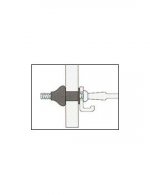
![DSC_0447[1].jpg](/community/data/attachments/646/646600-4e06ae2b6b7484ca47534d80f8c5becc.jpg)
![DSC_0449[1].jpg](/community/data/attachments/646/646613-033985899fd7574cd43e0fe786d083fb.jpg)
![DSC_0451[1].jpg](/community/data/attachments/646/646627-d4164a57ef367d45c8f8379cfd81d404.jpg)
